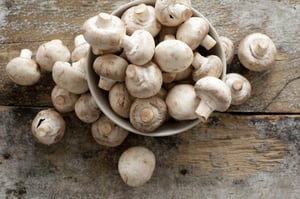By Makayla Heibel, MS, RD, LDN
 Mushrooms are low in calories and high in nutritional value, containing vital nutrients like vitamin D, potassium, and B vitamins. They contain ergosterol — a beneficial plant compound and vitamin D precursor — which converts to vitamin D when exposed to light, making mushrooms the only source of vitamin D in the produce aisle. Vitamin D helps to facilitate the body’s absorption of calcium, which is essential for bone and teeth health.
Mushrooms are low in calories and high in nutritional value, containing vital nutrients like vitamin D, potassium, and B vitamins. They contain ergosterol — a beneficial plant compound and vitamin D precursor — which converts to vitamin D when exposed to light, making mushrooms the only source of vitamin D in the produce aisle. Vitamin D helps to facilitate the body’s absorption of calcium, which is essential for bone and teeth health.
Nutritional Benefits
Mushrooms contain significant amounts of three B-complex vitamins: riboflavin (B2), niacin (B3), and pantothenic acid (B5). B vitamins play an important role in allowing the body to utilize energy from the protein, carbohydrate, and fat in the foods we consume.
Mushrooms also contain potassium. Diets high in potassium may help reduce blood pressure, as potassium is a primary mineral responsible for regulating fluid balance, muscle contractions, and nerve signals.
How to Enjoy
Both nutritious and delicious, mushrooms contain beneficial compounds that create a savory, hearty, and “meat-like” flavor known as umami, one of the five basic tastes. With the variety of edible mushrooms in various shapes, sizes, colors, textures, and flavor properties, there is sure to be a way to incorporate this nutritious ingredient into your diet.
• Add sliced white button mushrooms to your salads, pizza, or spaghetti sauce
• Mix chopped chanterelle mushrooms with your scrambled eggs to enjoy a sweet and peppery breakfast entree
• Sauté oyster mushrooms with garlic to serve on top of steak or in a pasta dish
• Stuff cremini (baby bella) mushrooms with cheese, herbs, and spices and bake in the oven
• Mix minced portabella mushrooms with ground beef or turkey for added nutrients in taco meat or burgers
• Add Shiitake mushrooms — a common mushroom in Asian cuisine — into a stir-fry
A few tips for selecting and storing mushrooms:
• Like humans, mushrooms can produce vitamin D following exposure to ultraviolet B light (UVB). Choose mushrooms indicated as "UVB" — or exposed to sunlight — to get the most of that "sunshine vitamin" (vitamin D)
• Choose mushrooms with a firm texture, even color, and tightly closed caps
• Wait to wash mushrooms until you are ready to cook to avoid them spoiling early
• Store in the fridge in the original package or an open paper bag to maintain airflow
• To clean, brush them off with your fingers, then rinse and pat dry with a paper towel
Ready to cook with mushrooms? Try out this North Carolina Cherry Cola Chicken Sandwich with Portobello Mushrooms and Pimento Cheese from Chef Peter Tseng.


.png?width=1278&name=HHS-company%20logo-final%20(1).png)